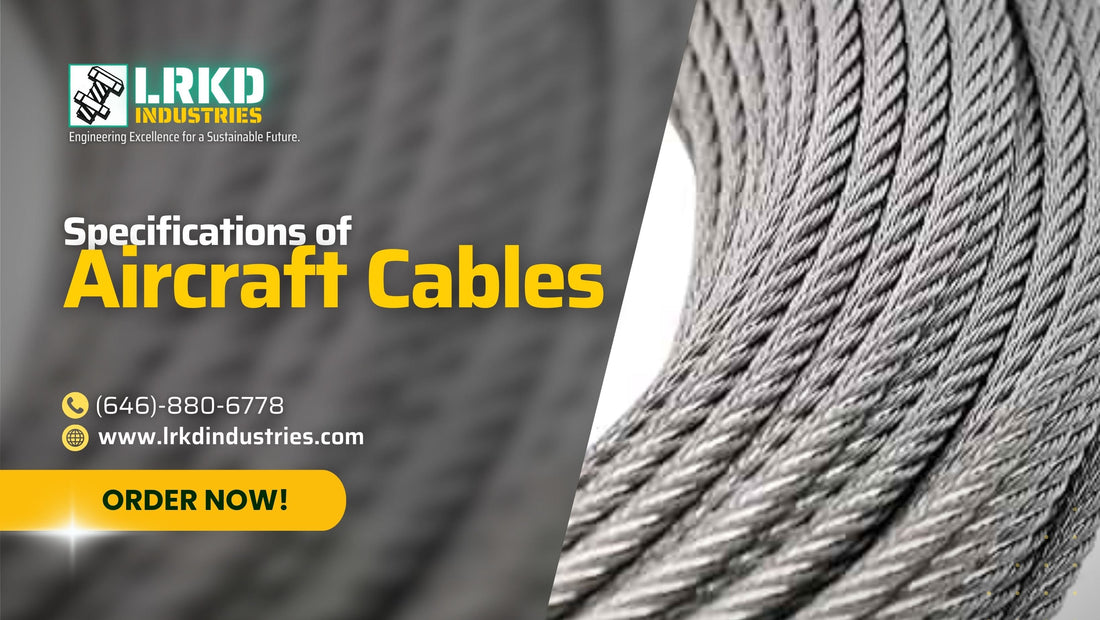Picture yourself on a tall building site, watching cranes move bulky objects with ease. What keeps these loads safe and guards against disastrous failures? Aircraft cables, a crucial but sometimes disregarded element in the construction sector, hold the key to the solution. These cables were first created for aviation, but because of their strength, flexibility, and longevity, they are now essential in contemporary building.
This blog will explain the characteristics of aviation cables, their preferred use in building, and how to pick the best one for your project. This tutorial is for anybody working in the construction business or simply interested in the technology underlying structural safety.
What Are Aircraft Cables?
Originally created for use in aircraft, aircraft cables—also referred to as wire ropes—are flexible, high-strength steel cables. But because of their adaptability, they are a popular option for building projects where safe lifting, support, and suspension are essential. To create a sturdy yet flexible framework, many strands of stainless steel or galvanized wires are twisted together to create these cables.
Why Use Aircraft Cables in Construction?
High Tensile Strength – Can withstand heavy loads and high stress.
Corrosion Resistance – With galvanized or stainless-steel options, these cables can endure harsh environments.
Flexibility – Suitable for intricate installations and tight spaces.
Durability – Designed to last longer, reducing maintenance costs.
Safety – Minimizes the risk of structural failures due to breakage.
Aircraft Cable Specifications: What to Look For
1. Material Composition
Aircraft cables are available in two primary materials:
|
Material |
Characteristics |
Best For |
|
Galvanized Steel |
Coated with zinc to prevent rust and corrosion |
General construction, outdoor applications |
|
Stainless Steel (304/316) |
Superior corrosion resistance, ideal for marine or extreme weather |
High-end construction projects, coastal regions |
2. Strand Configuration
Aircraft cables come in different strand configurations, which impact their flexibility and strength. The most common ones include:
|
Strand Type |
Composition |
Features |
Common Uses |
|
7x7 |
7 strands with 7 wires each |
Moderate flexibility, strong, durable |
Medium-duty lifting, rigging |
|
7x19 |
7 strands with 19 wires each |
More flexible, higher strength |
Pulley systems, winches, suspension bridges |
|
1x19 |
1 strand with 19 wires |
Stiff, less flexible but very strong |
Guy wires, structural applications |
3. Cable Diameter and Load Capacity
The thickness of an aircraft cable determines its load-bearing capacity. Below is a table outlining common diameters and their corresponding load capacities.
|
Diameter (inches) |
Breaking Strength (lbs) |
Recommended Application |
|
1/16" |
480 – 920 |
Light-duty construction, small pulleys |
|
3/32" |
920 – 2,000 |
Safety lines, railing supports |
|
1/8" |
2,000 – 3,700 |
General lifting, scaffolding |
|
3/16" |
4,200 – 7,000 |
Heavy-duty hoisting, rigging |
|
1/4" |
7,000 – 12,000 |
Structural support, crane cables |
4. Coating Options
Coatings can enhance the durability and weather resistance of aircraft cables. The most common options include:
Vinyl Coating – Adds a protective layer, prevents fraying, improves grip.
Nylon Coating – Increases resistance to abrasion and chemicals.
Lubricated Cables – Reduce friction and extend lifespan.
How to Choose the Right Aircraft Cable for Construction
Selecting the right aircraft cable depends on multiple factors:
Identify the Load Requirements – Choose a cable with a breaking strength at least 5 times the expected load.
Consider Environmental Conditions – Use stainless steel for corrosive environments and galvanized steel for general applications.
Flexibility vs. Strength – For pulleys, go with 7x19; for structural support, opt for 1x19.
Check Regulatory Standards – Ensure compliance with OSHA, ASTM, and construction safety guidelines.
Factor in Coating Needs – If exposure to harsh elements is high, nylon or vinyl coatings can extend cable longevity.
Common Applications in Construction
Aircraft cables serve a variety of roles in construction, including:
Lifting and Hoisting – Used in cranes, winches, and elevators for moving heavy materials safely.
Structural Support – Provides stability in bridges, suspension walkways, and skyscrapers.
Safety Applications – Utilized in fall protection systems, guard rails, and scaffolding.
Tensioning Systems – Used in pre-stressed concrete for reinforcement.
Temporary and Permanent Fencing – Aircraft cables act as high-strength barriers on construction sites.
Maintaining Aircraft Cables for Long-Term Use
To ensure maximum safety and efficiency, regular maintenance is essential:
✅ Inspect for Wear & Tear – Check for frays, kinks, and corrosion before each use.
✅ Apply Lubrication – Reduces internal friction, extending cable lifespan.
✅ Store Properly – Keep in dry, ventilated areas to prevent rust.
✅ Replace When Necessary – If strands start breaking, immediately replace the cable.
Aircraft Cable Specification Support
Save your engineers and procurement team some time! Whether it’s for aviation construction, maintenance, or cable assembly projects, LRKD Industries can provide detailed specification assistance for aircraft cables based on your technical requirements or project schematics. This service is ideal for teams needing precise cable data—including material type, diameter, strand configuration, and strength ratings—without the research hassle.
Contact LRKD Industries now for this time-saving service!
👉 Submit your project details today for a FREE consultation and aircraft cable specification evaluation.
📍 Address: 98 N Industry CT, Deer Park, NY 11729, US
📞 Phone: +1 646-880-6778
📧 Email: info@lrkdindustries.com
We are also able to provide cable data sheets in formats compatible with digital modeling software, including ".dwg", ensuring seamless integration into your engineering workflows.
For more information about our aircraft cable products, click here.
When safety and performance matter most, precision in specification isn’t optional—it’s critical.


